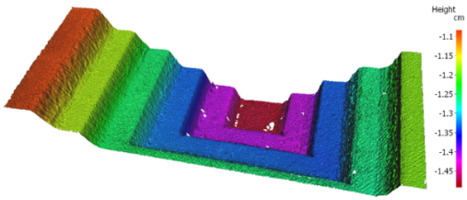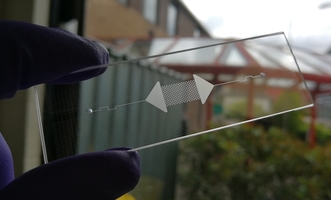Fibre Optic Applications
Sensors in Additive Layer Manufactured Components
Point of contact: Bill MacPherson (W.N.MacPherson@hw.ac.uk)Components manufactured by Additive Layer Manufacture (ALM), commonly referred to as 3D printing, are increasingly being used in applications where traditional manufacturing routes are not feasible. These components benefit from in-situ monitoring and this project aims to developp techniques for embedding novel sensor components.
Distributed temperature and srain sensing within metallic ALM structures is important to monitor component health and help to predict potential failure mechanisms. The goal of
this project is to investigate novel strategies that enable integration of optical fibre based sensors into metalic ALM components. The project aims to demonstrate the abiity
to produce distributed arrays of metal embedded sensors with a primary goal leading towards the production of an embedded array of temeperature sensors.
Embedding strategies including fibre metalisation, ALM process optimisation, and post embedding characterisation and treatment will be considered. Initial stages of this work
will concentrate on using convnetional communications grade single mode fibre, incorporating Fibre Bragg Gratings, as the core sensing technology.
Ben Michie, Bill MacPherson, Robert Maier
Development of Fibre-Based Gas Sensor for Inaccessible Locations
Point of contact: Bill MacPherson (W.N.MacPherson@hw.ac.uk)Optical gas sensor technologies can provide important data that can be used to infer the presence of chemical ageing processes that can occur within a hermetically sealed system. This project aims to achieve sensitive and selective gas speciation measurements while also considering the chemical and physical constraints with regards to the system within which the sensor is located.
The detection of certain gas species can provide important information of the various chemical ageing processes occurring within a system. Regarding this project’s current application,
it is critical that this detection mechanism is non-extracting and non-destructive within a hermetically sealed system and is capable of achieving high sensitivity and selective
measurements. The primary gases of interest are O2, NOx and COx.
Currently, the investigation of broad-band cavity-enhanced absorption spectroscopy is being conducted. The utilisation of a laser-driven light source, capable of fibre coupling,
allows for broad-band light to be coupled into an optical cavity formed by two highly reflective mirrors. The light leaked from the cavity is then dispersed through a spectrometer
and is detected by a photomultiplier tube. The concentration level of gases can then be determined by the optical absorption that occurs within the gas cell.
Tamer Y. Cosgun, Dr William N. MacPherson, Dr Simon Brooks (AWE)
Hollow-core anti-resonant negative curvature optical fibres (HC-ARF) for high-peak power laser applications
Point of contact: Prof Duncan Hand (D.P.Hand@hw.ac.uk)Hollow-core anti-resonant negative curvature optical fibres exhibit extraordinary transmission capability and flexibility for delivering high peak power ultrashort laser pulses. This project aims to find and break the limits of these fibres, and to explore their great potential in high peak power applications.
When light propagates through the quasi-vacuum environment in hollow core optical fibres instead of silica in conventional fibres, transmission is no longer limited by solid
materials. The anti-resonant glass layer with a “negative curvature” structure surrounding the core can confine 99% of the mode energy in the air core, providing an ultralow
attenuation. The combination of these features enables ultrashort pulses to propagate through the fibre with ultralow loss and ultrahigh damage threshold. The goal of this
project is to investigate and expand the capability of hollow core anti-resonant guiding fibres (HC-ARF) (provided by the University of Bath) to transmit ultrashort laser
pulses in all wavelength ranges, including the characterization and improvement of their important transmission properties such as transmission loss, bending loss, dispersion,
nonlinearity, polarization maintaining, mode quality, coupling efficiency, and maximum transmittable power. High-power laser applications such as laser precision manufacturing
and laser medical treatment can benefit from the result of this project. In cooperation with our industrial partners, the practical applications of ultrafast laser delivered by
HC-ARF is becoming more reliable, flexible and convenient by all means.
This project was supported by projects EP/M025888/1, EP/I01246X/1, EP/M025381/1, and EP/I011315 financed by Engineering and Physical Sciences Research Council, UK.
Shouyue Wu, Bartlomiej Siwicki, Richard M. Carter, Jonathan D. Shephard, Duncan P. Hand, EPSRC, Coherent, M-Solv, Litron Lasers, University of Bath, Powerlase
Distributed Fibre Sensors
Point of contact: Bill MacPherson (W.N.MacPherson@hw.ac.uk)Distributed fibre optic sensors show great promise in applications requiring monitoring over long distances (kilometers). By taking advantage of different forms of backscattering in the fibre, a range of sensors can be produced. Rayleigh, Raman and Brillouin scattering are three mechanisms of backscatter which can occur in an optical fibre under light excitation.
Due to the fundamental mechanisms behind them, the temperature, strain (or shape, depending on the configuration) can be detected at any point along the fibre by measuring the backscatter as a function of time. Demand in a number of industries including aerospace, land transportation and offshore energy is increasing for fully distributed and accurate measurements of these quantities at both hundreds of kilometres and over shorter ranges (metres) for component monitoring. The goal of this research is to determine how accurately this demand can be met and over what distances. James Jackson, Bill MacPherson, Henry Bookey
Read More
